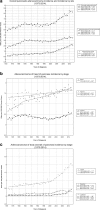Trends in pancreatic adenocarcinoma incidence and mortality in the United States in the last four decades; a SEER-based study
- PMID: 29940910
- PMCID: PMC6020186
- DOI: 10.1186/s12885-018-4610-4
Trends in pancreatic adenocarcinoma incidence and mortality in the United States in the last four decades; a SEER-based study
Abstract
Background: Pancreatic cancer is the fourth-leading cause of cancer deaths in the United States. The silent nature of the disease and its poor prognosis, the need for further research, along with the need to assess the outcomes of current approaches necessitate an ongoing evaluation of the epidemiology and mortality-trends of this malignancy. Continuous monitoring of disease-patterns, on population-levels, may help scientists assess the quality of healthcare delivery, boost their understanding of diseases' characteristics and risk factors, and detect gaps whereby further research is needed. None of the previous reports shed light on pancreatic adenocarcinomas (PAC), the most common type of Pancreatic Cancer, as the primary outcome. In this study we aim to investigate PAC's incidence and mortality trends over the last four decades in the United States.
Methods: We used SEER 9 database to study PAC cases during 1974-2014. Incidence and mortality rates were calculated by sex, age, race, state and stage of PAC. Annual percent change (APC) was calculated using joinpoint regression software.
Results: We reviewed 67,878 PAC cases; most of these cases were in the head of pancreas. Overall PAC incidence rates increased 1.03% (95% CI, 0.86-1.21, p <.001) per year over the study period. Rates of adenocarcinoma of the head of pancreas increased 0.87% (95% CI, 0.68-1.07, p <.001), and rates of adenocarcinoma of the body and tail of pancreas increased 3.42% (95% CI, 3.06-3.79, p <.001) per year during 1973-2014. PAC incidence-based mortality increased 2.22% (95% CI, 1.93-2.51, p <.001) per year. However, during 2012-2014 there was a statistically significant decrease in PAC incidence-based mortality; APC, -24.70% (95% CI, -31.78 - -16.88, p <.001).
Conclusion: PAC's incidence and mortality rates have been increasing for decades. However, the last few years have shown a promising decrease in mortality. We believe that further advances in healthcare delivery and research can lead to a further mortality decrease. Future studies can use this paper as a baseline to keep monitoring the outcomes of PAC's therapy.
Keywords: Incidence; Mortality; Pancreatic adenocarcinoma; SEER.
Conflict of interest statement
Ethics approval and consent to participate
We got approval from the National Cancer Institute to use data of patient from SEER database. Participant consent was not necessary as this study involved the use of a previously-published de-identified database according to SEER database.
Consent for publication
Not applicable
Competing interests
The authors declare that they have no competing interests.
Publisher’s Note
Springer Nature remains neutral with regard to jurisdictional claims in published maps and institutional affiliations.
Figures


References
-
- Siegel RL, Miller KD, Jemal A. Cancer statistics, 2016. CA: a cancer journal for clinicians. 2016;66(1):7–30. - PubMed
-
- National Cancer Institute. Estimated new cancer cases and deaths for 2013. SEER (Surveillance Epidemiology and End Results) cancer statistics review. Available from: http://www.seer.cancer.gov.
-
- De La Cruz M, Young AP, Ruffin MT. Diagnosis and management of pancreatic cancer. Am Fam Physician. 2014;89(8):626–632. - PubMed
MeSH terms
LinkOut - more resources
Full Text Sources
Other Literature Sources
Medical

